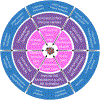Classes of therapeutics to amplify the immune response
- PMID: 34787761
- PMCID: PMC11646685
- DOI: 10.1007/s10549-021-06369-3
Classes of therapeutics to amplify the immune response
Abstract
Purpose: Conventional chemotherapies are a mainstay for metastatic breast cancers, though durable response is rare. Immunotherapies promise long-term responses thorough immune activation but have been underwhelming in breast cancer relative to other cancer types. Here, we review the mechanisms of existing strategies including chemotherapies and how they may cause breast cancers to become immunogenic to identify potential biomarkers for combinations of conventional and immunotherapies.
Conclusion: Mechanistic considerations should inform biomarker development and patient selection for therapeutic combinations of drugs to combine with immune-checkpoint inhibitors.
Keywords: Immunogenic cell death; T-cell activation; Targeted therapies; Taxane; cGAS-STING.
© 2021. The Author(s), under exclusive licence to Springer Science+Business Media, LLC, part of Springer Nature.
Figures

Similar articles
-
cGAS-STING and PD1/PDL-1 pathway in breast cancer: a window to new therapies.J Recept Signal Transduct Res. 2024 Feb;44(1):1-7. doi: 10.1080/10799893.2024.2325353. Epub 2024 Mar 12. J Recept Signal Transduct Res. 2024. PMID: 38470108 Review.
-
Manganese is critical for antitumor immune responses via cGAS-STING and improves the efficacy of clinical immunotherapy.Cell Res. 2020 Nov;30(11):966-979. doi: 10.1038/s41422-020-00395-4. Epub 2020 Aug 24. Cell Res. 2020. PMID: 32839553 Free PMC article. Clinical Trial.
-
Breast cancer immunobiology driving immunotherapy: vaccines and immune checkpoint blockade.Expert Rev Anticancer Ther. 2012 Dec;12(12):1597-611. doi: 10.1586/era.12.147. Expert Rev Anticancer Ther. 2012. PMID: 23253225 Free PMC article. Review.
-
Immune Checkpoint Blockade Therapy for Breast Cancer: Lessons from Epithelial-Mesenchymal Transition.Mol Diagn Ther. 2023 Jul;27(4):433-444. doi: 10.1007/s40291-023-00652-3. Epub 2023 May 16. Mol Diagn Ther. 2023. PMID: 37193859 Free PMC article.
-
Activating cGAS-STING pathway for the optimal effect of cancer immunotherapy.J Hematol Oncol. 2019 Apr 1;12(1):35. doi: 10.1186/s13045-019-0721-x. J Hematol Oncol. 2019. PMID: 30935414 Free PMC article. Review.
References
-
- Sung H, Ferlay J, Siegel RL, Laversanne M, Soerjomataram I, Jemal A, et al. Global cancer statistics 2020: GLOBOCAN estimates of incidence and mortality worldwide for 36 cancers in 185 countries. CA: A Cancer Journal for Clinicians [Internet]. 2020. [cited 2021 Feb 19]; Available from: https://acsjournals.onlinelibrary.wiley.com/doi/abs/10.3322/caac.21660 - DOI - PubMed
-
- Waks AG, Winer EP. Breast Cancer Treatment: A Review. JAMA. 2019;321:288–300. - PubMed
-
- Dent R, Trudeau M, Pritchard KI, Hanna WM, Kahn HK, Sawka CA, et al. Triple-Negative Breast Cancer: Clinical Features and Patterns of Recurrence. Clin Cancer Res. American Association for Cancer Research; 2007;13:4429–34. - PubMed
Publication types
MeSH terms
Grants and funding
LinkOut - more resources
Full Text Sources
Medical
Research Materials

